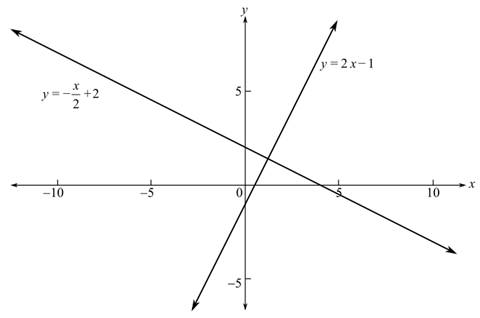
In Exercises 1–6, graph the given equations and determine how many solutions the system has, if any.
To graph: The system of equations consisting of
Explanation of Solution
Given Information:
The system of equations is;
Graph:
Consider the equations,
Rewrite the given equations,
Use the graphing calculator to determine the solution of the given system of equation,
Step 1: In the TI-83 calculator press the ON key.
Step 2: Click on the
Step 3: Write the desired equation in
Step 4: Press the
Step 5: Press the
The graph is shown below;

From the graph, it can be observed that the graphs of the system of equation intersect at a single point.
Interpretation:
As the graphs of the equation intersect at a single point there is a unique solution for the given system of equation.
Want to see more full solutions like this?
Chapter 3 Solutions
Finite Mathematics
- In a small office, there are m = 5 typists who need to use a single typewriter to complete their reports. Assume the time each typist takes to prepare a report follows an exponential distribution with an average of 20 minutes per preparation (A = 3 reports/hour), and the service time for the typewriter to type out a report also follows an exponential distribution, averaging 30 minutes to complete a report (μ 2 reports/hour). Given that the number of typists is finite and all typists = share one typewriter, they will form a waiting queue. (1). Describe this queuing system and explain how it fits the characteristics of the M/M/1/∞0/m model. (2). Calculate the probability that any typist is using the typewriter at steady-state. (3). Calculate the average number of typists waiting in the queue at steady-state. (4). Considering the need to reduce waiting time, if an additional typewriter is introduced (turning into a two-server system, or M/M/2/∞0/m model), analyze the expected impact,…arrow_forwardUse Laplace transform to solve the initial value problem y' + y = tsin(t), y(0) = 0arrow_forwardThe function g is defined by g(x) = sec² x + tan x. What are all solutions to g(x) = 1 on the interval 0 ≤ x ≤ 2π ? A x = = 0, x == = 3, x = π, x = 7 4 , 4 and x 2π only = B x = 4' 1, x = 1, x = 57 and x = 3 only C x = πk and x = - +πk D , where is any integer П x = +πk and П x = +πk, where k is any integerarrow_forward
- Business discussarrow_forwardVector v = PQ has initial point P (2, 14) and terminal point Q (7, 3). Vector v = RS has initial point R (29, 8) and terminal point S (12, 17). Part A: Write u and v in linear form. Show all necessary work. Part B: Write u and v in trigonometric form. Show all necessary work. Part C: Find 7u − 4v. Show all necessary calculations.arrow_forwardAn object is suspended by two cables attached at a single point. The force applied on one cable has a magnitude of 125 pounds and acts at an angle of 37°. The force on the other cable is 75 pounds at an angle of 150°.Part A: Write each vector in component form. Show all necessary work.Part B: Find the dot product of the vectors. Show all necessary calculations Part C: Use the dot product to find the angle between the cables. Round the answer to the nearest degree. Show all necessary calculations.arrow_forward
- An airplane flies at 500 mph with a direction of 135° relative to the air. The plane experiences a wind that blows 60 mph with a direction of 60°.Part A: Write each of the vectors in linear form. Show all necessary calculations.Part B: Find the sum of the vectors. Show all necessary calculations. Part C: Find the true speed and direction of the airplane. Round the speed to the thousandths place and the direction to the nearest degree. Show all necessary calculations.arrow_forwardUse sigma notation to write the sum. Σ EM i=1 - n 2 4n + n narrow_forwardVectors t = 3i + 7j, u = 2i − 5j, and v = −21i + 9j are given.Part A: Find the angle between vectors t and u. Show all necessary calculations. Part B: Choose a value for c, such that c > 1. Find w = cv. Show all necessary work.Part C: Use the dot product to determine if t and w are parallel, orthogonal, or neither. Justify your answer.arrow_forward
- Algebra & Trigonometry with Analytic GeometryAlgebraISBN:9781133382119Author:SwokowskiPublisher:Cengage
